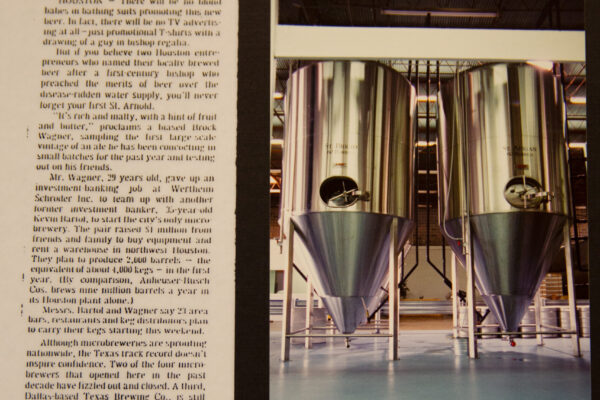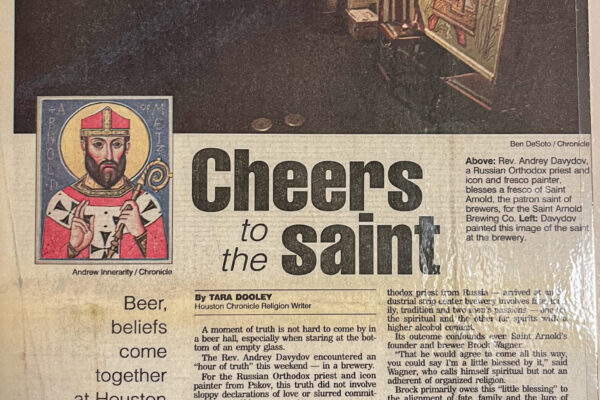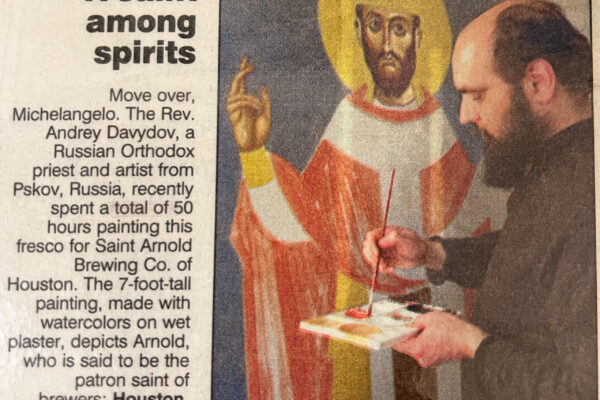
About Us
Texas' Oldest Craft Brewery
Saint Arnold Brewing Company, located in Houston, is Texas’ Oldest Craft Brewery. Our goal is to brew world class beers and deliver them to our customers as fresh as possible making them the best beers in Texas and Louisiana. Our customers are beer lovers – people that appreciate great, full-flavored beers.
We brew several different beers; some are year round, some are seasonal, some are special release, and a few are single batch brews. They are available in bars, restaurants, grocery stores, liquor stores and warehouse stores throughout Texas and Louisiana.
Our small crew does everything at the brewery: brew the beer, filter the beer, keg the beer, bottle the beer, sell the beer and drink the beer. For us, this is a passion, not a job. We believe that this comes through in the beers we make. Our beers have soul.
Our first keg of beer was shipped on June 9, 1994. Founded by Brock Wagner and Kevin Bartol, we chose Houston because, other than living here, this was the largest city in the country that did not have a microbrewery. Brock was a longtime homebrewer and had considered opening a brewery as far back as college, although that was quickly dismissed as a silly idea. Seven years after graduating, Brock revisited the idea, enlisted Kevin’s help and the brewery was off and running. Kevin has since left the business after a bitter battle. (Just kidding – but don’t you wish people wrote that when it was the truth?).
Please visit us if you are in Houston. We are open seven days a week.
Cheers!
Saint Arnold
The Guy
(Condensed from “Saint Arnoul: Ancêtre de Charlemagne et des Européens”)
T o the Europeans in quest of their family history, Metz uncovers a birthplace: Saint Arnold, Mayor of the Palace a bishop who then became a hermit, the paternal ancestor and spiritual father of French Christendom. One cannot forget that Charlemagne was a 6th generation descendent of Saint Arnold. Whenever one refers back to distant periods, the facts and myths get mixed together to create the legend.
The life of Saint Arnold is known to us by one of his contemporaries. It was published in the “Acta Sanctorum ordinis S. Benedicti” and in the “Scriptora Rerum Merovingicarum.”
Arnold was born around 580 in Layum castle, today known as Lay-Saint-Christophe near Nancy in the country known as Austrasia . His father was Baudgise (d. 588), Palace Mayor and Duke of Sueve. His mother was Oda. After successful Latin studies, Arnold was taken under the tutelage of Gondulphe who was either Bishop of Metz or Palace Mayor. Subsequently, Arnold was recommended to King Theodebert II where he was placed in charge of the palace of government of the province of Moselle.
It was in Moselle around 600 that Arnold married Dode, daughter of the Count of Boulogne. They had many children, including sons Ansegisel and Clodulf. Clodulf, later St. Cloud, also became a Bishop of Metz. Ansegisel’s descendants include Pepin d’Heristal, Charles Martel, Pepin le Bref and finally Charlemagne.
Arnold lived during a period of much turmoil in the region. There were many wars, rulers were poisoned, others were captured and tortured to death. It may have been these horrors that caused Arnold to enter the Church. He was chosen as the 29th Bishop of Metz by the people and the clergy of Metz and enthroned near the end of 612.
His election as bishop ruined his plan to move to the Lernis monastery with his friend Romary. Also around this time, Dode moved to a Benedictine convent near Treves and no more is known about her.
Arnold played a large role in the Edict of 615 which laid out 2 fundamental laws:
It did away with the outright permanence of hereditary land, stating that the nobles had to continue to actively manage the lands to continue their ownership.
It decreed that bishops were to be elected by the faithful, not appointed by king.
Arnold played an important role in the politics of his time, being a close advisor to King Dagobert and participated in the councils of Paris (614), Metz, Reims (625) and Clichy (627). Yet he longed to retire to solitude and did so in 629.
After leaving as bishop, he moved to a mountain near Remiremont where he built a chapel. Here he sheltered lepers and others rejected by society.
His reputation attracted young men who wanted to live a solitary religious life, but Arnold directed them to his friend Romary’s monastery near Remiremont. Arnold lived alone at his retreat and died on August 16, 640. Romary conducted his funeral and had him buried at Arnold’s mountain chapel.
The people of Metz wanted to intern the remains of Arnold at their cathedral. In 641, the then Bishop of Metz, Goery, Tiffory, the Bishop of Toul and Paul, the Bishop of Verdun, went to reclaim Arnold’s remains and led a procession to Metz where he was reburied at the abbey of Saints Apostles which later became the Abbey of Saint Arnold. When the abbey was razed in 1552 by the Duke of Guise during the siege of Metz by Charles V, the venerated relics were returned to inside of Metz. The abbey that acquired them named their tower after Saint Arnold. Today the building is the mess hall for the garrison officers and the road that goes under the building is called “Under Saint Arnold”.
Legends of
Saint Arnold
There are three legends associated with Saint Arnold:
Legend of the Ring
Arnold was tormented by the violence that surrounded him and feared that he had played a role in the wars and murders that plagued the ruling families. Obsessed by these sins, Arnold went to a bridge over the Moselle river. There he took off his bishop’s ring and threw it into the river, praying to God to give him a sign of absolution by returning the ring to him.
Many penitent years later, a fisherman brought to the bishop’s kitchen a fish in the stomach of which was found the bishop’s ring. Arnold repaid the sign of God by immediately retiring as bishop and becoming a hermit for the remainder of his life.
Legend of the Fire
At the moment Arnold resigned as bishop, a fire broke out in the cellars of the royal palace and threatened to spread throughout the city of Metz. Arnold, full of courage and feeling unity with the townspeople, stood before the fire and said, “If God wants me to be consumed, I am in His hands.” He then made the sign of the cross at which point the fire immediately receded.
Legend of the Beer Mug
It was July 642 and very hot when the parishioners of Metz went to Remiremont to recover the remains of their former bishop. They had little to drink and the terrain was inhospitable.
At the point when the exhausted procession was about to leave Champigneulles, one of the parishioners, Duc Notto, prayed “By his powerful intercession the Blessed Arnold will bring us what we lack.” Immediately the small remnant of beer at the bottom of a pot multiplied in such amounts that the pilgrims thirst was quenched and they had enough to enjoy the next evening when they arrived in Metz.





